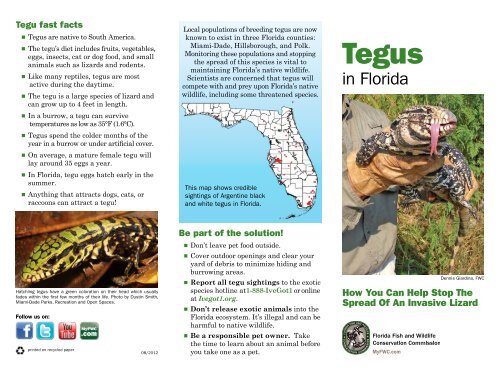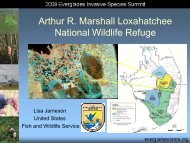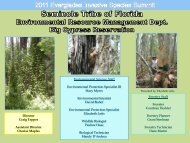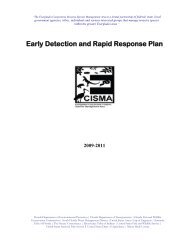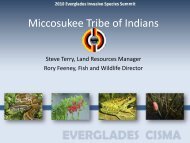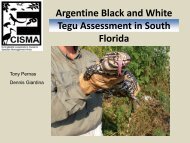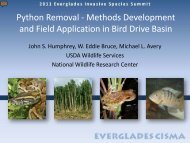Tegus in Florida brochure 2012 - Everglades Cooperative Invasive ...
Tegus in Florida brochure 2012 - Everglades Cooperative Invasive ...
Tegus in Florida brochure 2012 - Everglades Cooperative Invasive ...
You also want an ePaper? Increase the reach of your titles
YUMPU automatically turns print PDFs into web optimized ePapers that Google loves.
Tegu fast factsn <strong>Tegus</strong> are native to South America.n The tegu’s diet <strong>in</strong>cludes fruits, vegetables,eggs, <strong>in</strong>sects, cat or dog food, and smallanimals such as lizards and rodents.n Like many reptiles, tegus are mostactive dur<strong>in</strong>g the daytime.n The tegu is a large species of lizard andcan grow up to 4 feet <strong>in</strong> length.n In a burrow, a tegu can survivetemperatures as low as 35°F (1.6°C).n <strong>Tegus</strong> spend the colder months of theyear <strong>in</strong> a burrow or under artificial cover.n On average, a mature female tegu willlay around 35 eggs a year.n In <strong>Florida</strong>, tegu eggs hatch early <strong>in</strong> thesummer.n Anyth<strong>in</strong>g that attracts dogs, cats, orraccoons can attract a tegu!Local populations of breed<strong>in</strong>g tegus are nowknown to exist <strong>in</strong> three <strong>Florida</strong> counties:Miami-Dade, Hillsborough, and Polk.Monitor<strong>in</strong>g these populations and stopp<strong>in</strong>gthe spread of this species is vital toma<strong>in</strong>ta<strong>in</strong><strong>in</strong>g <strong>Florida</strong>’s native wildlife.Scientists are concerned that tegus willcompete with and prey upon <strong>Florida</strong>’s nativewildlife, <strong>in</strong>clud<strong>in</strong>g some threatened species.This map shows crediblesight<strong>in</strong>gs of Argent<strong>in</strong>e blackand white tegus <strong>in</strong> <strong>Florida</strong>.<strong>Tegus</strong><strong>in</strong> <strong>Florida</strong>Hatchl<strong>in</strong>g tegus have a green coloration on their head which usuallyfades with<strong>in</strong> the first few months of their life. Photo by Dust<strong>in</strong> Smith,Miami-Dade Parks, Recreation and Open Spaces.Follow us on:pr<strong>in</strong>ted on recycled paper08/<strong>2012</strong>Be part of the solution!n Don’t leave pet food outside.n Cover outdoor open<strong>in</strong>gs and clear youryard of debris to m<strong>in</strong>imize hid<strong>in</strong>g andburrow<strong>in</strong>g areas.n Report all tegu sight<strong>in</strong>gs to the exoticspecies hotl<strong>in</strong>e at1-888-IveGot1 or onl<strong>in</strong>eat Ivegot1.org.n Don’t release exotic animals <strong>in</strong>to the<strong>Florida</strong> ecosystem. It’s illegal and can beharmful to native wildlife.n Be a responsible pet owner. Takethe time to learn about an animal beforeyou take one as a pet.Dennis Giard<strong>in</strong>a, FWCHow You Can Help Stop TheSpread Of An <strong>Invasive</strong> Lizard
What is a tegu?The Argent<strong>in</strong>e black andwhite tegu, Tup<strong>in</strong>ambismerianae, is an exoticlizard that has been<strong>in</strong>troduced to<strong>Florida</strong>.<strong>Tegus</strong> are an <strong>in</strong>vasive species which reproducesquickly and eats a wide variety of fooditems, <strong>in</strong>clud<strong>in</strong>g small animals and eggsof many wildlife species. <strong>Tegus</strong> are nowknown to have breed<strong>in</strong>g populations <strong>in</strong>Miami-Dade, Polk, and Hillsboroughcounties. It is believed the populations werefounded by escaped or released pets. Theblack and white tegu is native to SouthAmerica, specifically to Brazil, Paraguay,Uruguay, and Argent<strong>in</strong>a.<strong>Tegus</strong> are black and white <strong>in</strong> color withband<strong>in</strong>g along the tail. They can reach upto four feet <strong>in</strong> length. The lizards spendmost of their time on land, though they canswim and may submerge themselves for longperiods of time. <strong>Tegus</strong> can often be seen onroadsides or other disturbed areas. Likemany reptiles, they are primarily activedur<strong>in</strong>g the day and will burrow or hideovernight.The <strong>Florida</strong> Fish and Wildlife ConservationCommission (FWC) is currently work<strong>in</strong>gwith other agencies and organizationsto assess the threat of this species anddevelop management strategies. Onestrategy be<strong>in</strong>g used by FWC, theUniversity of <strong>Florida</strong>, Miami-Dade County,and USGS is targeted trapp<strong>in</strong>g andremoval. The goal of these partnershipsis to m<strong>in</strong>imize the impact of tegus onnative wildlife and natural areas.Dust<strong>in</strong> Smith, Miami-Dade Parks, Recreation and Open SpacesWhat to do if you see a tegu1. Take a picture2. Note the location3. Report the sight<strong>in</strong>gReport<strong>in</strong>g your sight<strong>in</strong>g will help wildlifemanagers better understand where theanimals are found. Sight<strong>in</strong>gs can bereported over the phone to our exotic speciesreport<strong>in</strong>g hotl<strong>in</strong>e at 1-888-Ive-Got1(1-888-483-4681) or onl<strong>in</strong>e at Ivegot1.org.A phone app for report<strong>in</strong>g exotics is alsoavailable; search for the free IveGot1 app.Tony Pernas, National Park ServiceThe FWC does not recommend that youattempt to capture the animal! While ategu is not likely to be <strong>in</strong>nately aggressiveit will defend itself if aggravated or threatened.<strong>Tegus</strong> have sharp teeth, strong jaws, andsharp claws which they will use to defendthemselves. The best method for remov<strong>in</strong>gtegus is by trapp<strong>in</strong>g.If you see a tegu on your property you cancontact a local wildlife trapper to removethe animal. A list of trappers <strong>in</strong> your countycan be found at myFWC.com. <strong>Tegus</strong> are notprotected by any of <strong>Florida</strong>’s wildlife lawsbut local ord<strong>in</strong>ances will apply depend<strong>in</strong>gon the location.


